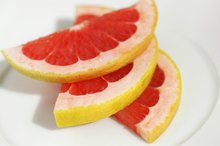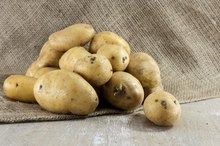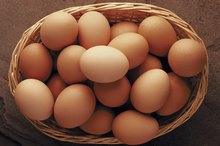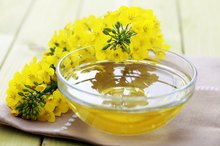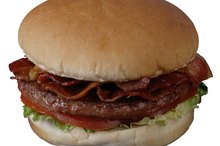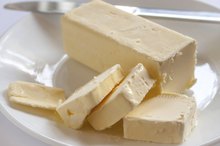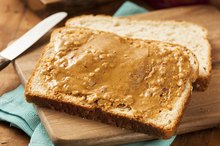Few people can get through life without ever having clogged pores. Clogged pores are a harmless but annoying cosmetic condition that is particularly common in adolescents. Although for decades the dermatological community has insisted that there was no link between diet and acne, recent research has indicated that the foods you eat can indeed give rise to clogged pores, which in turn gives rise to acne 1.
What are Pores?
Pores are the tiny openings through which hair follicles can rise to the surface of the skin. The hair follicle itself remains deep beneath the surface, in the dermal layer of skin. In addition to allowing hair to break through the skin, pores permit oil, also called sebum, and sweat to rise to the surface of the skin.
Cause of Clogged Pores
Are Brown Rice and Sweet Potatoes Good for Acne?
Learn More
Pores become clogged when the oil-producing glands, or the sebaceous glands, in your skin begin to produce higher than usual amounts of sebum. So much oil is produced that much of it cannot exit through the pores, which causes them to become clogged. Dead skin cells and dirt can also get trapped in the opening, causing pores to become clogged.
Effects of Clogged Pores
Clogged pores are a major contributing factor to acne. According to the American Academy of Dermatology, a certain kind of bacteria called P. acnes thrives in the excess oil from clogged pores and causes inflammation. Whiteheads are inflamed, clogged pores in which the surface of the pore is closed. Blackheads are clogged pores in which the surface of the pore remains open. In dermatology terminology, whiteheads and blackheads are called closed and open comedos, respectively. Both are forms of acne.
- Clogged pores are a major contributing factor to acne.
- Whiteheads are inflamed, clogged pores in which the surface of the pore is closed.
Clogged Pores and Diet
Beta Carotene for Acne
Learn More
Recent studies have demonstrated a link between clogged pores and nutrition. According to a 2002 study published in the journal "Archives of Dermatology" and led by Loren Cordain, a high-glycemic diet results in acne breakouts. The researchers concluded that the increase in acne was due to a rise of insulin levels and insulin-like growth factor, which in turn caused an increase of testosterone, which, in its turn, caused on overproduction of sebum.cause:
- The researchers concluded that the increase in acne was due to a rise of insulin levels
- insulin-like growth factor
- which in turn caused an increase of testosterone
- which
- in its turn
- caused on overproduction of sebum
Excess sebum can result in clogged pores. In short, a high-glycemic diet -- one rich in simple carbohydrates and sugars -- might trigger the overproduction of oil that causes clogged pores and acne.
- Recent studies have demonstrated a link between clogged pores and nutrition.
- According to a 2002 study published in the journal "Archives of Dermatology" and led by Loren Cordain, a high-glycemic diet results in acne breakouts.
Low-Glycemic Foods
To eliminate or prevent clogged pores through diet, avoid eating high-glycemic foods and maintain a low-glycemic diet. Low-glycemic foods include whole grain foods, cruciferous and dark leafy green vegetables, dry beans of all varieties, and certain fruits such as:
- cherries
- plums
- grapefruit
- peaches
Milk and highly processed foods are also items to avoid.
Other Treatment for Clogged Pores
Eating well is only part of the equation for getting rid of clogged pores. You also have to treat your skin right. The website “Care Fair” recommends gently washing your face with warm water and soap every day to get rid of excess oil. It also recommends exfoliating dead skin with products containing natural ingredients such as oatmeal, ground almonds or orange peel. You should also make sure that products you use on your skin, such as sunscreen and other toiletries, are oil-free.
- Eating well is only part of the equation for getting rid of clogged pores.
- The website “Care Fair” recommends gently washing your face with warm water and soap every day to get rid of excess oil.
Related Articles
References
- GI News: What Connection is There Between a High GI Diet and Acne?
- Flament F, Francois G, Qiu H, et al. Facial skin pores: a multiethnic study. Clin Cosmet Investig Dermatol. 2015;8:85–93. Published 2015 Feb 16. doi:10.2147/CCID.S74401
- Maia Campos PMBG, Melo MO and Mercurio DG (2019) Use of Advanced Imaging Techniques for the Characterization of Oily Skin. Front. Physiol. 10:254. doi: 10.3389/fphys.2019.00254
- Makrantonaki E, Ganceviciene R, Zouboulis C. An update on the role of the sebaceous gland in the pathogenesis of acne. Dermatoendocrinol. 2011;3(1):41–49. doi:10.4161/derm.3.1.13900
- Flament F, Francois G, Qiu H, et al. Facial skin pores: a multiethnic study. Clinical, Cosmetic and Investigational Dermatology. 2015;8:85-93. doi:10.2147/CCID.S74401
Writer Bio
Barbara Diggs is a freelance writer living in France. A former corporate lawyer, she has been writing professionally since 2006. She has been published in numerous print and online magazines, specializing in travel, parenting, history and law. Diggs is a graduate of Wesleyan University and Stanford Law School.

